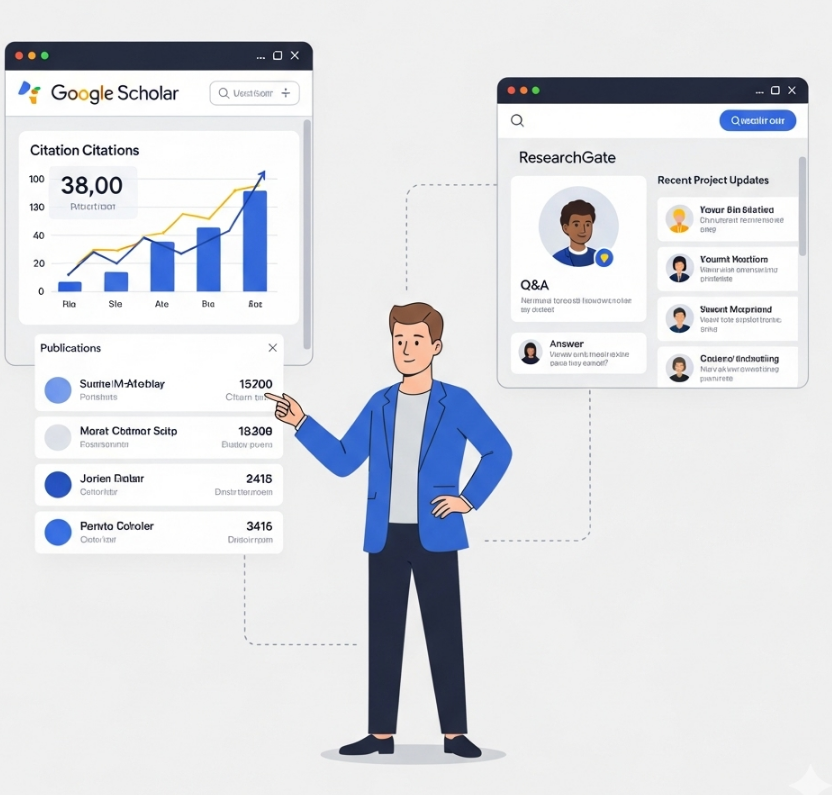In today's digital academic landscape, your
research impact is measured not just by your publications, but also by your
online visibility. Google Scholar and ResearchGate are two of the most powerful
platforms for showcasing your work, connecting with peers, and tracking your
citations.

However, a "set it and forget it"
approach won't work. Actively managing these profiles is essential to ensure
they are accurate, complete, and professionally represent you and your
research. This guide provides actionable steps to take control of your academic
digital identity.
Part 1: Mastering Your Google Scholar
Profile
Google Scholar is often the first place
other researchers will look for your work. Its strength lies in its simplicity
and powerful citation tracking.
1. Create and Curate Your Profile
- Initial Setup: If you don't have a
profile, go to Google Scholar and click "My Profile." The setup
wizard will ask for your affiliation, research interests, and a university
email for verification. Using an official academic email is crucial for
credibility.
- Professional Photo: Add a clear,
professional headshot. A profile with a photo is more engaging and appears
more legitimate.
- Keep Affiliation and Interests Updated: Did you move to a new university or shift your research focus?
Update your affiliation and keywords in your profile. This helps others
find you and ensures your work is correctly attributed.
2. Actively Manage Your Publications
List This is the most important part of managing
your profile. Google Scholar's algorithm is good, but it's not perfect.
- Initial Import: When you first set
up your profile, Google Scholar will suggest a list of articles it thinks
are yours. Review this list carefully and select only your work.
- Add Articles Manually: If Google
misses a publication (common with book chapters or some conference
papers), you can add it yourself. Click the + icon on your profile and
choose "Add article manually."
- Fix Errors and Merge Duplicates:
Sometimes, one of your articles may appear as two separate entries (e.g.,
one from a preprint server and one from the journal). Select both entries
and use the "Merge" action to combine them. This consolidates
all citations into a single, correct record.
- Delete Incorrect Entries: If an
article that isn't yours appears on your profile, select it and click
"Delete." Regularly checking your profile for these errors is
good practice.
3. Set Up Alerts Stay informed about your impact and new research in your field.
- Citation Alerts: Create an alert to
receive an email whenever one of your publications is cited.
- Keyword Alerts: Set up alerts for
new papers published in your area of interest to stay current with the
latest research.
Part 2: Engaging on Your ResearchGate
Profile
ResearchGate is more of a social network
for scientists and researchers. It's about interaction and showcasing a broader
range of your academic contributions.
1. Build a Comprehensive Profile Your ResearchGate profile is your academic CV.
- Complete All Sections: Fill out
your biography, research experience, skills, and expertise. The more
complete your profile, the more discoverable you are.
- Add a Detailed "About" Summary: Use this section to give a narrative overview of your research
journey, current projects, and what you are passionate about.
2. Showcase All Your Research Outputs ResearchGate allows you to share more than just peer-reviewed
articles.
- Upload Your Papers: For each
publication, you can often upload a full-text version. Be mindful of
publisher copyright agreements—you can usually upload a pre-print or
post-print version, but not the final published PDF. ResearchGate often
provides guidance on this.
- Add Other Research: Did you create
a dataset, design a poster, or give a conference presentation? Add these
to your profile. This provides a more holistic view of your work.
- Create Projects: Use the
"Projects" feature to group related research and provide ongoing
updates. This is great for sharing work-in-progress and attracting
potential collaborators.
3. Interact with the Community This is what sets ResearchGate apart.
- Ask and Answer Questions: The
Q&A section is a valuable tool. Answering questions in your area of
expertise demonstrates your knowledge and builds your reputation.
- Follow Researchers and Topics:
Follow key opinion leaders in your field and relevant research topics to
create a customized news feed.
- Recommend and Comment: Engage with
the work of others by recommending papers you find interesting or leaving
thoughtful comments.
Quick Comparison: Key Management Tasks
|
Task
|
Google Scholar
|
ResearchGate
|
|
Primary Goal
|
Track publications and citations
accurately.
|
Network, share research, and engage.
|
|
Adding Papers
|
Mostly automatic with manual correction.
|
Mostly manual upload.
|
|
Content Types
|
Primarily articles, books, and patents.
|
Articles, pre-prints, posters, datasets,
presentations.
|
|
Key Action
|
Correcting, merging, and deleting
records.
|
Uploading content and interacting with
others.
|
|
Social Features
|
Minimal (alerts).
|
Extensive (Q&A, follows, comments).
|
Conclusion
Think of your Google Scholar profile as
your official, public-facing library of work and your ResearchGate profile as
your dynamic, interactive research lab. By spending just a little time each
month curating both, you can build a powerful and professional online presence
that accurately reflects your academic contributions and opens doors to new
opportunities.


